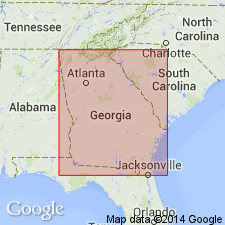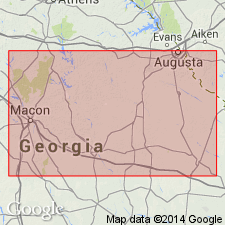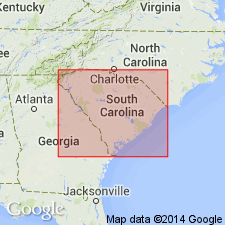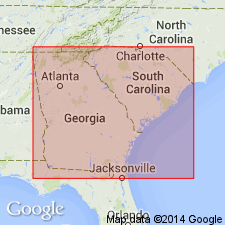
- Usage in publication:
-
- Utley Limestone Member
- Modifications:
-
- Named
- Dominant lithology:
-
- Limestone
- AAPG geologic province:
-
- South Georgia sedimentary province
Summary:
Utley Limestone Member of Clinchfield Formation is here named in Burke Co., eastern GA. Utley is a sandy, glauconitic limestone measuring 4 m thick in core at Griffins Landing. Described as cavernous and fossiliferous. Patchy distribution due to deposition in topographic lows or to solution. Unconformably overlies Lisbon Formation; underlies Dry Branch Formation of Barnwell Group. Age is late Eocene.
Source: GNU records (USGS DDS-6; Reston GNULEX).

- Usage in publication:
-
- Utley Limestone Member
- Modifications:
-
- Areal extent
- AAPG geologic province:
-
- South Georgia sedimentary province
- Atlantic Coast basin(?)
Summary:
Utley Limestone is here formally named. [Unit was annotated for Lexicon from 1979 Open-File Report by same authors.] Utley is known to occur only in Burke and Screven Cos., GA, but it is probably present in SC. Overlies Lisbon Formation (middle Eocene); underlies Twiggs Clay Member of Dry Branch Formation.
Source: GNU records (USGS DDS-6; Reston GNULEX).

- Usage in publication:
-
- Utley Limestone Member
- Modifications:
-
- Overview
- Areal extent
- AAPG geologic province:
-
- Atlantic Coast basin
Summary:
In the study area, Siple (1967) assigned the lower part of the upper Eocene to the McBean Formation and the upper part to the Barnwell and Hawthorn formations. Authors here follow the stratigraphic terminology of Huddlestun and Hetrick (1985) for the upper Eocene. The basal upper Eocene unit is the Clinchfield Formation, which consists of glauconitic, biomoldic limestone, calcareous sand and clay, and tan and yellow quartz sand. The quartz sand is probably the Riggins Mill Member, and the calcareous part is the Utley Limestone Member. The lower contact of the Clinchfield with the middle Eocene Santee Limestone is probably unconformable. The Clinchfield is about 25 ft thick in the southeastern part of the Site and pinches out or becomes unrecognizable in the center of the Savannah River Site. Thickness for Utley not given. Clinchfield appears to correlate biostratigraphically with the Gosport or Moodys Branch Formation of the Gulf Coastal Plain.
Source: GNU records (USGS DDS-6; Reston GNULEX).

- Usage in publication:
-
- Utley Limestone Member*
- Modifications:
-
- Overview
- Biostratigraphic dating
- AAPG geologic province:
-
- Atlantic Coast basin
Summary:
Three Priabonian (late Eocene) depositional sequences are recognized at the Savannah River Site, which represent the Utley Limestone, the Dry Branch Formation, and the Tobacco Road Sand. The Utley (member of the Clinchfield) contains abundant PERIARCHUS LYELLI on the Savannah River Site and establishes its correlation with the "scutella bed" of the lower Moodys Branch Formation of the eastern Gulf Coastal Plain.
Source: GNU records (USGS DDS-6; Reston GNULEX).
For more information, please contact Nancy Stamm, Geologic Names Committee Secretary.
Asterisk (*) indicates published by U.S. Geological Survey authors.
"No current usage" (†) implies that a name has been abandoned or has fallen into disuse. Former usage and, if known, replacement name given in parentheses ( ).
Slash (/) indicates name conflicts with nomenclatural guidelines (CSN, 1933; ACSN, 1961, 1970; NACSN, 1983, 2005, 2021). May be explained within brackets ([ ]).

